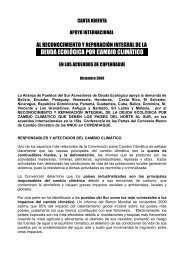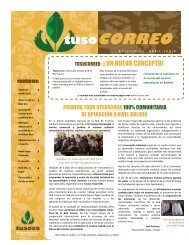Beyond Greening - Tourism Watch
Beyond Greening - Tourism Watch
Beyond Greening - Tourism Watch
Create successful ePaper yourself
Turn your PDF publications into a flip-book with our unique Google optimized e-Paper software.
<strong>Beyond</strong> <strong>Greening</strong>: Reflections on <strong>Tourism</strong> in the Rio-Process | PositioningpaperForests, Communities and the "Green India Mission":Promises and Failures of EcotourismBy EquationsMarket-based conservation schemes seek to mobilise and channel private sector contributionsfor the sake of environmental conservation and to resolve various environmental problems.They are actively propagated as an innovative approach "[t]o attract private contributions,introduce sustainable resource management practices compatible with the Rio Conventions’objectives and principles, and contribute to the development of economic opportunities inpoor, rural areas of the world" (Paquin/Mayrand, 2005). These schemes are promoted by alarge variety of governmental and non-governmental actors as a possible new and innovativeway to finance the conservation of forests and other ecosystems 19 . In India, ecotourism is onesuch scheme being promoted because it speaks the language of conservation.<strong>Tourism</strong> is a sector that is built and relies on natural capital (both human and ecological) andthis makes issues of sustainability very critical. Globally, the new interest in tourismenvironmentinterrelations is particularly notable with rising concerns about the links betweentourism and climate change. In this context, an interesting trend is evident when notions ofsustainability lead to class dimensions of tourism. Under the banner of sustainability, policymakers clamour for "high-value low-volume" tourists. This is a recurrent theme in severaltourism policy and planning documents in India. This suggests a form of neo-colonialismdisguised as green, as it defines those who deserve to travel solely by their ability to spend.India's National Action Plan on Climate ChangeThe Government of India announced its first ever National Action Plan on Climate Change(NAPCC) in June 2008 to identify measures and steps to advance climate change-relatedactions in its domestic sphere. Eight National Missions in the areas of solar energy, enhancedenergy efficiency, sustainable agriculture, sustainable habitat, water, the Himalayanecosystem, increasing forest cover and strategic knowledge for climate change wereincorporated under the Plan by the Prime Minister’s Council on Climate Change, reflectingIndia’s vision and domestic strategies for sustainable development and the steps it must taketo realize it.According to the NAPCC, the Green India Mission (GIM), being one of the eight NationalMissions, was launched to enhance eco-system services, including carbon sinks, to be calledGreen India. "The Mission on Green India will be taken up on degraded forest land throughdirect action by communities, organized through Joint Forest Management Committees andguided by the department of forest in state governments", the NAPCC document stated. TheMission has two focused objectives – increasing forest cover and density as a whole of thecountry and conserving biodiversity and recommended implementation of the alreadyannounced <strong>Greening</strong> India Programme.The Green India Mission document envisages tourism as offering an alternative livelihoodto communities dependent on natural resources in coastal ecosystems like mangroves and in19 For example, in his note on Incentive Measures to the 11th meeting of the Subsidiary Body on Scientific, Technical and TechnologicalAdvice (SBSTTA) the Executive Secretary of the Convention on Biological Diversity states that “market creation has often proved to be aneffective means for the conservation and sustainable use of biodiversity”.26












